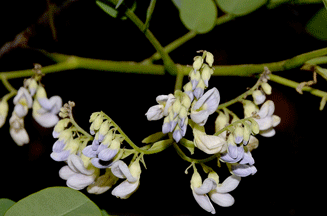Dalbergia calcarea, a new species of Dalbergia (Fabaceae: Dalbergieae) from Lao PDR
DOI:
https://doi.org/10.20531/tfb.2024.52.2.08Keywords:
Faboideae, Indo-China, Laos, new taxon, taxonomyAbstract
Dalbergia calcarea, a new species currently only known from the limestone mountains of Khammouan Province, central Laos, is described and illustrated. The key characters such as habit, colour and limb of standard, and number of ovules of the new species are discussed and compared with its closest relatives. A detailed description along with etymology, conservation status, illustrations and colour photographs are provided for a new species. This discovery increases the number of Laotian species in the genus Dalbergia to seventeen taxa.
Downloads
References
Adema, F., Ohashi, H. & Sunarno, B. (2016). Notes on Malesian Fabaceae (Leguminosae-Papilionoideae) 17. The genus Dalbergia. Blumea 61: 186–206. https://doi.org/10.3767/000651916X693905.
Cardoso, D., Pennington, R.T., de Queiroz, L.P. , Boatwright, J.S., Van Wyk, B.-E., Wojciechowski, M.F. & Lavin, M. (2013). Reconstructing the deep-branching relationships of the papilionoid legumes. South African Journal of Botany 89: 58–75. https://doi.org/10.1016/j.sajb.2013.05.001.
Chen, D.Z., Zhang, D.X. & Larsen, K. (2010). Dalbergia. In: Z.Y. Wu, P.H. Raven & D.Y. Hong (eds), Flora of China 10: 121–130. Science Press, Beijng.
IUCN Standards and Petitions Committee (2022). Guidelines for Using the IUCN Red List Categories and Criteria. Version 15.1. Prepared by the Standards and Petitions Committee. https://www.iucnredlist.org/documents/RedListGuidelines.pdf [Accessed 10 January 2023].
Klitgaard, B.B. & Lavin, M. (2005). Dalbergia L.f. In: G. Lewis, B. Schrire, B. Mackinder & M.
Lock (eds), Legumes of the World. Royal Botanic Gardens, Kew, p. 327.
Lavin, M., Pennington, R.T., Klitgaard, B.B., Sprent, J.I., de Lima, H.C. & Gasson, P.E. (2001).The Dalbergioid legumes (Fabaceae): delimitation of a pantropical monophyletic clade.American Journal of Botany 88: 503–533.
Lock, J.M. & Heald, J. (1994). Legumes of Indo-China, a check-list. Royal Botanic Gardens, Kew.
Newman, M.F., Ketphanh, S., Svengsuksa, B., Thomas, P., Lamxay, V. & Armstrong, K. (2007). A checklist of the vascular plants of Lao PDR. Royal Botanic Garden Edinburgh, Edinburgh.
Niyomdham, C. (2002). An account of Dalbergia (Leguminosae-Papilionoideae) in Thailand. Thai Forest Bulletin (Botany) 30: 124–166. https://li01.tci-thaijo.org/index.php/ThaiForestBulletin/article/view/24860.
Niyomdham, C. (2018). Dalbergia L.f. In: H. Balslev & K. Chayamarit (eds), Flora of Thailand 4 (3.1): 221–487. The Forest Herbarium, Bangkok.
Niyomdham, C., Hô, P.H., Phon, P.D. & Vidal, J.E. (1997). Leguminosae-Papilionoideae: Dalbergieae. In: P. Morat (ed.), Flore du Cambodge, du Laos et du Vietnam 29: 3–60. Museum National d’Histoire Naturelle, Paris.
Vatanparast, M., Klitgaard, B.B., Adema, F., Pennington, R.T., Yahara, T. & Kajita, T. (2013). First molecular phylogeny of the pantropical genus Dalbergia: implications for infrageneric circumscription and biogeography. South African Journal of Botany 89: 143–149. https://doi.org/10.1016/S0031-9422(97)00072-1.

Downloads
Published
How to Cite
Issue
Section
License
Copyright (c) 2024 The Forest Herbarium

This work is licensed under a Creative Commons Attribution-NonCommercial-NoDerivatives 4.0 International License.


